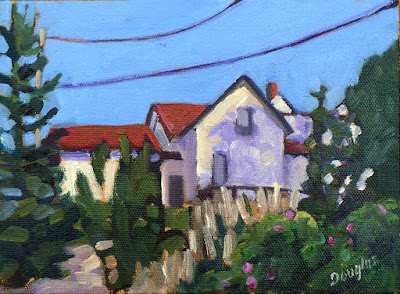Lighthouses are neither kitschy nor camp; they’re hardworking symbols of our maritime history.
 |
|
Lonely Lighthouse (Parrsboro, NS), Carol L. Douglas
|
This morning I am painting at Fort Williams State Park as part of Cape Elizabeth Land Trust’s 11th Annual Paint for Preservation. (Our locations are assigned; you can see a maphere.) This is the location of one of Maine’s most famous lighthouses, the beautiful Portland Head Light. It was first lit in 1791.
But I’ll be looking in the other direction. The Portland Head Light is unchanged from when Edward Hopper painted it in 1927. However, it would be difficult to set up in his vantage point now, since the park road runs over it. The lighthouse has been painted many, many times, and photographed even more often. I’d be hard-pressed to find anything new to say about it.
 |
|
Not a cloud in the sky (Owl’s Head Keeper’s House), Carol L. Douglas
|
Maine’s lighthouses have been painted so often, they have become in some ways a painting cliché. This is why critics sometimes sneer at lighthouse (along with lobster-boat) paintings. More fools they.
Our coastal history is both authentic and humble. There is evidence that people were building boats in Crete 130,000 years ago. Long before there were settled ports, people lit bonfires to guide mariners home. It didn’t take long before these were raised onto platforms. From there, the fixed tower was adopted.
 |
|
Dyce Head in the early morning light, Carol L. Douglas
|
By the time Alexander the Greatcame along, lighthouses were an established navigational aid. Ptolemy II Philadelphus built the Pharos of Alexandriasometime around the third century BC. It was the biggest and most famous lighthouse in antiquity. It lasted through seventeen centuries and several major earthquakes. In 1480, Sultan Al-Ashraf Sayf ad-Din Qa’it Bay tore down the remains and used the rubble to build a fort on the site. The Pharos was about 350 feet tall, whereas the Portland Head Light is 101 feet.
The oldest lighthouse still standing is the Tower of Herculesin Galicia, Spain. At 187 feet, it too stands taller than the Portland Head Light. Its exact date of construction is unknown, but it was known to be standing by the 2nd century AD, either built or rebuilt under the Emperor Trajan.
|
Owl’s Head Light, Carol L. Douglas
|
Like so much ancient technology, lighthouse construction went into hiatus with the fall of the Roman empire. The modern lighthouse era began in the eighteenth century with the development of international sea trading. The more boats there were on the water, the more horrific losses were suffered from shipwreck.
Advances in structural engineering made it possible to put lighthouses on surf-scoured rocks and even underwater ledges. The Bell Rock Lighthouse, balancing on a reef off the coast of Scotland, was built with such precision that its masonry hasn’t been replaced since it was completed in 1810. It was painted beautifully by J.M.W Turner in 1819.
 |
|
Cape Spear Road, Carol L. Douglas. That’s not one, but two, lighthouses.
|
The lighthouse keepers are long gone; their work has moved from oil lamps to remote operation by the Coast Guard. But they continue to serve a vital purpose on the seas.
Lighthouses come in a variety of shapes, from squat little caisson lights which look like sparkplugs, to tall, tapered towers, to the boxy little midcentury lighthouses of Nova Scotia. They’re often on remote, austere headlands, surrounded by pounding surf, lonely spruces, and great tumbles of rock.
How can anyone resist painting them?
